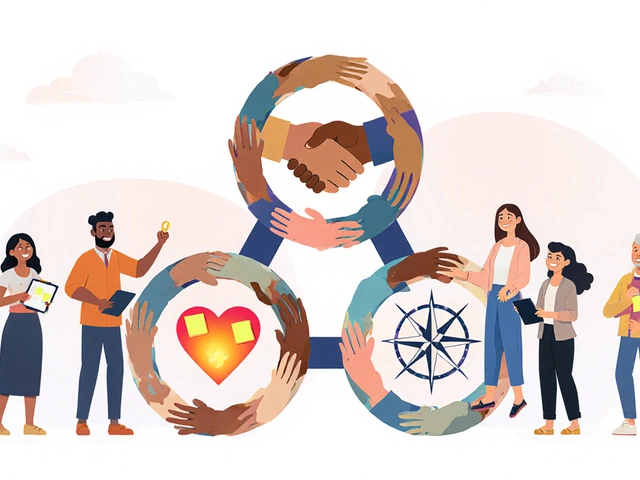If you want your outreach to do more than just make noise, you need an actual plan. Not a pile of ideas on sticky notes—an outreach plan ties everything together, so you aren’t stuck wondering what to do next or who’s in charge of what.
Skip the guesswork and start with your goals. What are you trying to achieve? Be as specific as possible. Maybe you’re trying to sign up 50 new volunteers in June, or you want teens in your neighborhood to use the new rec center. Vague targets make it almost impossible to know if you’re getting anywhere.
Defining your audience is next, and trust me, this step’s non-negotiable. If you talk to everyone, you actually talk to no one. Pin down who you want to reach. Are you focused on families, older adults, local businesses, or maybe a hard-to-reach group?
- Defining Outreach Goals
- Identifying Your Audience
- Crafting Key Messages
- Choosing Outreach Channels
- Setting Timelines and Roles
- Measuring Success
Defining Outreach Goals
Before you send a single email or host an event, you need to know what you’re actually hoping to accomplish. Every solid outreach plan starts here. Think about it: if you don’t have a clear target, how do you know if your outreach is working or just spinning its wheels?
First, your goals should be specific and measurable. For example, “increase community participation” sounds nice, but it’s vague. Try something like “get 100 people to sign up for our park cleanup next month.” Now you’ve got something you can actually measure and track.
- Set goals that are realistic for your team and resources. Don’t aim for 500 new volunteers if you only have the budget to train 20.
- Break big goals into smaller ones. If you eventually want to boost neighborhood safety, start with “host three safety workshops by September.”
- Align your goals with your organization’s mission. If your group helps families, don’t set out to reach local businesses just because it seems easy.
Most folks use the "SMART" method—Specific, Measurable, Achievable, Relevant, and Time-bound. It might sound like something off a business whiteboard, but it works. A goal like “connect with 30 local families through our July event and follow up with resources by August 15” is a way better outreach plan than a one-liner about “raising awareness.”
Once your goals are set, write them down and make sure everyone on your team knows what they are. A surprising number of outreach efforts fall flat just because the group was never 100% sure what they were aiming for.
Identifying Your Audience
You can’t reach people if you don’t know who they are. The most successful outreach plans start by locking in on exactly who their message is for. In the outreach plan world, this is where most projects either take off or fizzle out.
Start by asking these questions: Who is affected by the issue? Who stands to benefit from your program or message? Who’s been left out before? Break down your community by age, interests, location, and needs. For example, if your goal is to promote healthy eating, you’ll get better traction by choosing either parents, school kids, or local restaurants than if you blast the same info at everyone.
- Demographics: Age, gender, income, education, languages spoken.
- Geographics: Where do they live or gather? Neighborhoods, districts, or even specific apartment buildings.
- Interests and needs: What matters most to them? Are they worried about safety, youth activities, jobs, or something totally different?
- Preferred ways to get info: Are they on TikTok, do they use WhatsApp, or do they go old-school with flyers?
Here's what detailed audience research looks like in action:
| Project | Target Audience | How Identified | Best Channel to Reach |
|---|---|---|---|
| Free Health Clinic | Uninsured adults, 20-45 years old | Local survey, health department stats | Community centers, local radio |
| Teen Summer Camp | Teens, ages 13-18, local public schools | School counselor interviews; enrollment records | Instagram, school announcements |
| Neighborhood Food Drive | Families with young children | School meal program lists | Flyers, PTA emails, teachers |
This table isn’t just for show. It proves outreach isn’t a guessing game—it's about using real info. Surveys, focus groups, and even quick-checks with leaders or teachers help you hone in on the right people. You waste less time and money if you do the homework up front.
Once you know your audience, you can shape your message and methods to actually connect. That’s how you turn plans into real impact.
Crafting Key Messages
Your message makes or breaks your outreach plan. You want people to ‘get it’ instantly, not tune out. This isn’t the time for rambling stories or fancy slogans. Stick with what matters: what you’re asking, why it’s important, and how it affects the person on the receiving end.
People decide quickly whether they care. In fact, outreach plan research shows folks tend to make snap judgments on new info in just seven seconds. That’s all you get—so your key message needs to be sharp, clear, and easy to remember.
Don’t know what to include? Try thinking about these core pieces:
- What you need from your audience (Join? Show up? Share something?)
- Why they should care (What’s in it for them or their community?)
- Next step you want them to take (A website to visit, a person to call, an event to attend)
Clear and relatable language makes a difference. Avoid nonprofit jargon—say “We need neighbors to help at the park cleanup,” instead of “We seek community stewardship partners.” Test your drafts on folks outside your group. If it doesn’t make sense to them, go simpler.
Here’s a quick snapshot showing the difference between a vague and a sharp outreach message:
| Vague Message | Sharp Message |
|---|---|
| "Support our program for local youth." | "Volunteer for two hours this Saturday to help teens at our job skills workshop." |
| "Make a difference in your area." | "Sign up by Friday so we can assign you to a cleanup team in your neighborhood." |
Keep it short, honest, and relevant. Before you share anything publicly, check that every word helps people know what to do next—and why they should bother. That’s how your key message sticks.

Choosing Outreach Channels
Picking the right ways to actually reach your audience can make or break your outreach plan. It’s not about being everywhere all at once. It’s about showing up where your people actually are. Start by looking at what your audience uses and trusts. Social media? Local radio? Flyers at the grocery store? You need to be smart with your time and budget.
Here are a few common channels and what you need to consider:
- Social Media: If your group is younger, platforms like Instagram, TikTok, or Snapchat might be worth it. For general audiences, Facebook still rules the school with over 2.9 billion users according to Meta's 2024 data.
- Email: Email is still surprising strong. Mailchimp’s 2023 stats show nonprofit emails get an average open rate of 25%. Build clean lists, write snappy subject lines, and don’t spam people.
- Face-to-Face: Local events, door-knocking, or setting up at existing gatherings (like farmer’s markets) can seriously boost trust and engagement. In-person works well with older adults or tight-knit neighborhoods.
- Traditional Media: Think radio spots, local newspapers, or community bulletin boards. Cost varies, but local news can have a big reach for certain age groups—Pew Research found 56% of Americans still use radio weekly as of late 2023.
- Text Messaging: For important updates or reminders, SMS is direct and hard to ignore. Community groups often see response rates above 30% for texts, which blows most email rates out of the water.
Curious about what works best? Here’s a comparison table to make things clearer:
| Channel | Best For | Average Engagement Rate |
|---|---|---|
| Social Media | Youth, young adults, broad audiences | 6-15% |
| Adults 25-65, existing contacts | 25% | |
| Text Messaging | Quick alerts, reminders | 30%+ |
| Traditional Media | Older adults, local communities | Varies (radio up to 56% weekly reach) |
| Face-to-Face | Trust-building, deeper engagement | Hard to measure, but very high impact |
Don’t feel like you have to pick just one. Try a mix that fits your group and your message. Test what works, tweak as you go, and always make it easy for people to respond or get involved as soon as you catch their attention.
Setting Timelines and Roles
Ever notice how fast weeks fly by when you don’t actually put deadlines on your plans? That’s why every solid outreach plan needs a crystal-clear timeline and clear roles for everyone involved. Without these, things start slipping through the cracks, people’s responsibilities get blurry, and you end up wasting time chasing updates.
Start by breaking big objectives into smaller steps. If your goal is to run a community clean-up event, map out each part—like making flyers, ordering supplies, arranging snacks, and recruiting volunteers. For each task, lock down a start and end date, and then add regular check-ins. Google Calendar or even a shared spreadsheet gets everyone on the same page.
Assign every task to a specific person. Using labels like "Team,” or "Outreach Committee" just makes it too easy for everyone to assume someone else is handling it. Studies show that when individuals are named, accountability jumps. One 2023 survey of volunteer projects in Denver found teams met 38% more deadlines when jobs were tied to one person instead of a group label.
Here’s a quick way to organize your plan so you never lose track:
- List every action item, no matter how small.
- Give each item a deadline you can actually measure.
- Assign each item to one single person.
- Add a line for how you’ll check progress (like a quick text or a weekly call).
If you want a super-simple reference, check out this table example:
| Task | Assigned To | Deadline | Check-In Method |
|---|---|---|---|
| Design flyers | Taylor | June 7 | Slack Message |
| Contact local restaurants for snacks | Sam | June 10 | Weekly Call |
| Social media posts | Alex | June 12 | Email Update |
Timelines aren’t just busywork—they literally help your outreach plan actually happen. Plus, assigning clear roles means no one’s standing around at the last minute wondering what to do.
Measuring Success
If you don’t actually check whether your outreach plan worked, you might as well be throwing spaghetti at the wall. Success isn’t about guessing. It’s about tracking real numbers and seeing if you actually moved the needle.
First, set up simple ways to measure your goals. If your plan was to get more people at an event, count how many showed up. If you hoped for more newsletter signups, watch that list grow (or not). Tracking can be as basic as a sign-in sheet or as detailed as using Google Analytics for your digital efforts.
Don’t skip feedback. Ask your audience what worked for them. A quick survey—just three questions—can tell you a lot. Try using tools like Google Forms or SurveyMonkey to keep it easy. According to the Community Toolbox (University of Kansas),
"Taking time to measure your results can help you spot trends, avoid repeating mistakes, and make your next outreach even more effective."That’s not just theory—groups that take the time to review what happened improve their results the next time around.
Here are a few things you should track in most outreach plan efforts:
- How many people you reached, including attendance numbers or online views
- Level of engagement, like social shares or face-to-face questions
- Any changes in behavior—did people volunteer, donate, or spread the word?
- Feedback and comments from participants
Once you gather your data, actually look at it. If it turns out something flopped, dig into why. Maybe your message wasn’t clear, or you used the wrong channel for your target group. These lessons are pure gold for next time.








